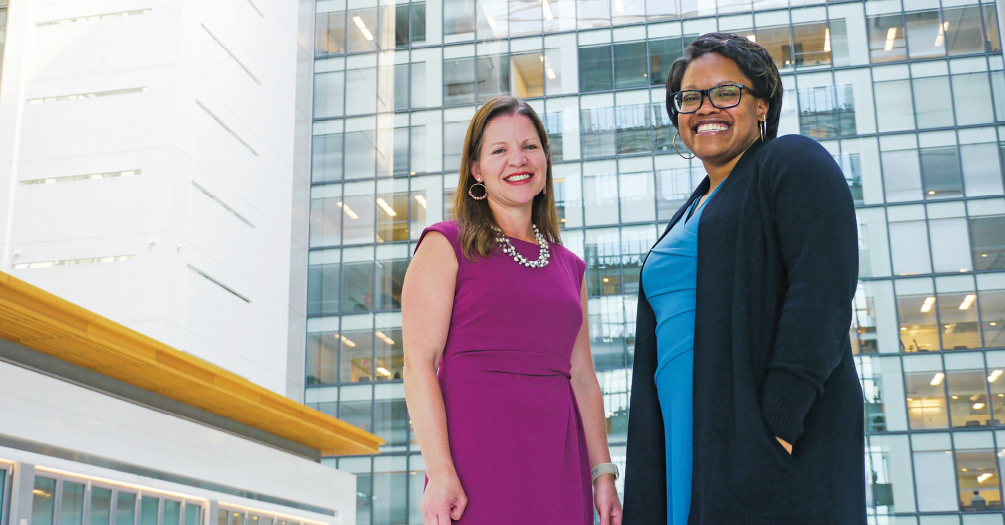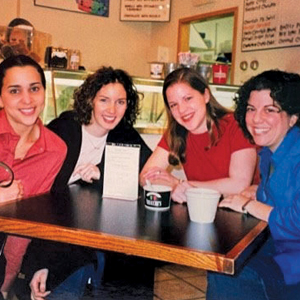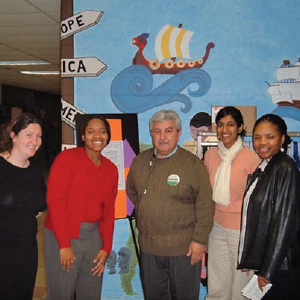Better together

Alumnae pair up to help healthcare facilities stay afloat during the pandemic and beyond
By Bob Cunningham
Colleagues Susan Marsiglia Gray, MPH ’01, and Tasha Akitobi, MPH ’05, share so much common ground, they practically read each other’s minds.
That comes in handy because their federal government workplace, the Provider Relief Bureau, is responsible for $200 billion in COVID relief funding. While their partnership is somewhat new—with only about 18 months of being on the job together—their paths to public health have created deep familiarity.
Both are Michiganders, with Gray growing up in Grand Rapids and Akitobi in Lansing. Each also received a bachelor’s degree from Michigan State University before earning a Master of Public Health in Health Behavior and Health Education from the University of Michigan School of Public Health.
The Provider Relief Bureau is a division of the Health Resources and Services Administration (HRSA), located within the US Department of Health and Human Services in Rockville, Maryland. HRSA is the primary federal agency for improving access to healthcare services for people who are uninsured, isolated or medically vulnerable.
Gray is the division director and Akitobi the deputy director. According to Gray, because they share core values acquired from Michigan Public Health and other commonalities, they work better together.
“Some of the core values from the School of Public Health that come to mind are collaboration and a focus on health equity,” Gray said. “I think because we both have those as core values, it’s made it easy for us to seamlessly co-lead.”
“The fact that both of us are from Michigan— both being U of M grads—there’s a lot of things that I don’t have to explain to Susan, even in terms of language I use,” Akitobi said.
Helping healthcare providers during a pandemic
In their roles, Gray and Akitobi are responsible for the policy development, program operations and communications for more than $200 billion in COVID-19 relief funding directed to healthcare providers and facilities across the nation. That includes both direct provider payments for healthcare-related expenses and lost revenues due to COVID-19 and claims reimbursement to healthcare providers that issue COVID-19 testing, treatment and vaccination to the uninsured.

“Healthcare providers and hospitals were struggling due to increased expenditures for COVID like needing more PPE (personal protective equipment) and to develop facilities that had better air circulation to help fight the virus,” Gray said. “There also were reduced revenues because of the loss of income from elective procedures, and then particular providers such as dentists or behavioral healthcare providers were closed for extended periods of time.”
In the Provider Relief Bureau, in general, Gray and Akitobi manage four broad, umbrella programs. The first and biggest is the $178 billion Provider Relief Fund that offers direct payments to healthcare providers for healthcare-related expenses and lost revenues attributable to COVID.
“We have a similar, but smaller $8.5 billion American Rescue Plan Act Rural Payments Program, which also provides direct payments to providers—but this is specifically for those who serve rural beneficiaries. And then we also manage two claims reimbursement programs.”
Their largest is the Uninsured Program, which dispenses claims reimbursement directly to healthcare providers for COVID-19 testing treatment and vaccination of the uninsured, and then a smaller program that covers vaccination administration to providers for individuals who are underinsured.
Both colleagues agreed that it can be difficult knowing if the program’s efforts have made a difference in people’s lives. Sometimes, numbers on a spreadsheet only tell part of the story.
“I think it’s really gratifying, especially because the day-to-day can feel like a slog,” Gray said. “For example, we were working with a communications contractor who was developing some provider testimonials. They interviewed some providers that had received Provider Relief Fund money, and we’re asking them what kind of impact that had on them. One of the providers who was interviewed is tearing up as he’s describing the impact. He said, ’This allowed me to stay open. This allowed me to continue to pay my staff.’ I think it’s easy to lose sight of that in the day-to-day, but this program really allowed the healthcare system in this country to stay afloat.”

“I recently went for a doctor’s appointment and was talking to my physician, and I told him what I do for a living,” Akitobi said. “He was like, ‘Oh my gosh, we actually got that money. Thank you so much.’ It’s been amazing to hear directly from people who’ve been impacted by this program and who’ve explicitly told us, ‘If this was not here, we would not be here.’"
I recently went for a doctor’s appointment and was talking to my physician, and I told him what I do for a living,” Akitobi said. “He was like, ‘Oh my gosh, we actually got that money. Thank you so much.’ It’s been amazing to hear directly from people who’ve been impacted by this program and who’ve explicitly told us, ‘If this was not here, we would not be here.’ - Tasha Akitobi
The Michigan connection
Gray and Akitobi have been working together since April 2021, but it seems longer to them—in a good way.
“We always joke that in the Provider Relief Bureau, a year equals 10 years because things have been moving so fast and furiously,” Gray said.
The Michigan duo discovered their many connections during the interview process.
“When Susan interviewed me and saw my resume, she saw that we both went to U of M, and discovered it during our interview, which was a nice surprise,” Akitobi said.
“I think even during the interview, we were chatting a little bit about professors we had in common when we were at Michigan Public Health,” Gray said.
Those professors and that similar training contributed to their sense of common core values.
“We both have kind of that community-based participatory research background, where a lot of those core values include seeing those who you are working for in terms of target populations as experts in their own health—really bringing that perspective to the work is definitely something that I think we have in common,” Akitobi said.
“When I first saw Tasha’s resume,” Gray said, “in addition to seeing that she had her MPH in Health Behavior and Health Education from Michigan, we both had a specialization in our undergrad at Michigan State.”
“Health and humanities,” Akitobi said.
“Right, health and humanities,” Gray said.
“The exact same specialization,” Akitobi said.
It’s almost like they were destined to work together.
“Exactly,” Gray said.
Finding their passion for Michigan Public Health
While working toward her human biology undergraduate degree, Akitobi worked as an adolescent health educator.
“I think that’s where I got the public health itch, which has carried me throughout my career,” she said. “I’ve only worked in public health, serving underserved communities, whether it be maternal and child health—and I know Susan also has that background—or even here in our own Provider Relief Bureau efforts.”
Gray said she had a similar experience.
“I initially went into my undergrad thinking I wanted to do medicine,” she said. “I know a lot of folks who end up in public health start there. I did an internship when I was an undergrad at the Michigan Public Health Institute and worked on a statewide child mortality prevention program. I realized there that I had more of an interest in the public health field and doing things that could affect health on a broader population scale vs. an individual patient scale.”
Akitobi wanted to stay near home for graduate school, but she also wanted one that provided a lot of on-the-ground collaboration work with communities—something she knew the University of Michigan was known for.
One of the great things about public health, Akitobi said, is that it is so broad that people with varying interests can find a little niche that really brings a level of excitement to their regular work.
“I love data, but I also love programming,” she said. “I love the community-based aspect of public health—the idea that to truly help support someone toward achieving that optimal health and well-being, you need to look at them as the experts in their own lives and even in their care and how they function in their community. The holistic approach that public health really pushes in terms of health and well-being of communities is something that I’m always interested in. Again, just the wide variety from epidemiology to the healthcare law, to the community engagement and organization, those are the things that excite me about public health.”
That interdisciplinary core that Gray received at Michigan Public Health still resonates with her in today’s workplace.
“One of the things I most appreciate is no matter what your concentration was, everybody who got an MPH was required to have classes in epidemiology, biostatistics, and health management and policy,” she said. “Both of us use those skills we learned in those classes every day, not only just the Health Behavior Health Education specialization we both have, but all those interdisciplinary skills.
“I think what drew me to public health overall was its focus on social determinants of health. What are all the things that affect the health of populations, and what can we do to change those things to bring about better health for populations overall? I was drawn to the idea of being able to make an impact for broader populations, and public health helps us do that.”
Akitobi wanted to strengthen her skills so she could continue to work within schools and communities as a peer health educator.
“Getting my master’s degree and getting that formal training allowed me to actually conduct various health education seminars and develop programming—something I really needed if I was going to continue to do that work,” she said. “Once I got to Michigan Public Health, I just loved it because it was so well-rounded. It wasn’t just health education and here are some theories. It was here is what you need to develop and run a program— all the things you need to be mindful of in management, budgeting, policy and so on. This approach was one of the things that drew me to the behavioral health education specialization.”
“One of the great things about the HBHE concentration was the focus on program management, program evaluation, survey design—a lot of the things that I know have been helpful to me throughout my federal career,” Gray said.
Both agreed that if they could do it all over again, they would have taken more biostatistics classes.
“That is one thing I have used more than I ever thought I would use,” Gray said.
Public health impacting people’s lives
When Gray and Akitobi were in Ann Arbor, being in a role that helped give a $200 billion life preserver to the healthcare industry never even entered their thoughts.
“No, not all,” Akitobi said. “All of this is unprecedented: from a pandemic on this scale with this impact and then this influx of dollars into the healthcare system. I don’t think we ever had any idea when we were both at U of M that at this point in our lives we would be a part of something like this. There’s no way we could’ve imagined it.”
It all comes down to health equity and access, values at the core of Michigan Public Health.
“I think the money had an even greater impact on rural and safety net providers, which were operating on even thinner margins,” Gray said. “They would definitely have gone out of business had it not been for this influx of money. Then there would’ve been all those individuals those businesses serve who would not have had access to healthcare. That part is particularly gratifying.”
Even though it took a pandemic to shine the light on the importance of public health, it could pay dividends for the future, Akitobi said.
 “I think that people see the value and that there’s even going to be more of a need
and a desire to have more people be public health professionals and be able to do
something like this,” she said. “It’s wide open for folks who are currently in their
public health studies to eventually get this opportunity to do something on this scale.”
“I think that people see the value and that there’s even going to be more of a need
and a desire to have more people be public health professionals and be able to do
something like this,” she said. “It’s wide open for folks who are currently in their
public health studies to eventually get this opportunity to do something on this scale.”
Gray agreed, pointing prospective students to Michigan Public Health, knowing they will be in good hands.
“I know that for students at the University of Michigan School of Public Health—because of its focus on interdisciplinary-based requirements on collaboration and the importance of health equity—the skills they’re learning and the values that they’re gleaning as part of their program are needed and will always be needed. I think in many ways they are more appreciated now as a result of the pandemic.” - Susan Marsiglia Gray
“I think the population at large—because of the COVID-19 pandemic—has become more aware of what public health is and why we need it and why it needs to be better funded,” she said.
“I know that for students at the University of Michigan School of Public Health—because of its focus on interdisciplinary-based requirements on collaboration and the importance of health equity—the skills they’re learning and the values that they’re gleaning as part of their program are needed and will always be needed. I think in many ways they are more appreciated now as a result of the pandemic.”
